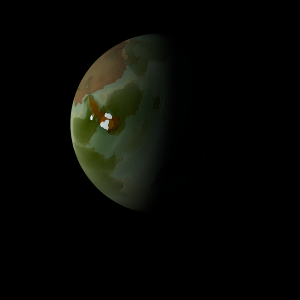|
|
Space Astro
|
Info for exoplanet "Mugyu Npopu"
| Scientific (actual) data |
|---|
| Name | Kepler-150 d |
| Planet status | Confirmed |
| Radius | 0.249 |
| Orbital period | 12.5609 |
| Semi major axis | 0.104 |
| Discovered | 2014 |
| Updated | 2021-02-05 |
| Tconj | 2455000 |
| Impact parameter | 0.12 |
| Publication | Announced on a website |
| Detection type | Primary Transit |
| Alternate names | 2MASS J19125618+4031152 d, K00408.02, KIC 5351250 d, KOI-408 d, KOI-408.02, WISE J191256.18+403115.1 d |
| Star name | Kepler-150 |
| Right ascension | 288.23° |
| Declination | 40.52° |
| Mag j | 13.817 |
| Mag h | 13.422 |
| Mag k | 13.367 |
| Star distance | 914.4 |
| Star metallicity | -0.136 |
| Star radius | 0.94 |
| Star temperature | 5560 |
| Star alternate names | 2MASS J19125618+4031152, KIC 5351250, KOI-408, WISE J191256.18+403115.1 |
| Wikipedia article | Kepler-150 d |
Back
| |
| Fictional info (?) |
|---|
| Suggested name | Mugyu Npopu |
| Planet type | Warm planet |
|
| Atmosphere | Nitrogen | 74% |
| Methane | 25% |
| Atmospheric pressure | 4 bar |
 |
| Moon | Tobyuryo | Huge round ice asteroid |
| Zopya | Huge slightly egg-shaped oceanic moon |
| Bibabe Ryo | Huge slightly egg-shaped gaseous comet |
| Zanegosha Byu | Small round ice planetoid |
| Hyopyu | Very small almost round gaseous comet |
| Maugu | Large slightly egg-shaped ice asteroid |
| Kike-hicha Wa | Very small almost round oceanic comet |
| Wachi'iyomyu'se | Huge almost round crater-filled moon |
| Tsubaso'koju | Medium-sized irregular oceanic asteroid |
| Babu'shuo'gomya | Medium-sized irregular crater-filled planetoid |
| Byocho-moakya'sa | Small round rocky comet |
| Jado Rota'bo | Medium-sized round oceanic moon |
| Hyugo-nezo Machu | Small potato shaped crater-filled planetoid |
| Pyorisa-za | Very small almost round ice asteroid |
| Roryaba Papugyu | Huge round ice comet |
| Shupate | Huge slightly egg-shaped oceanic asteroid |
| Nojone'byuko | Medium-sized round rocky comet |
| Hinyai | Large round oceanic moon |
| Joshonyu-kiba | Small round rocky planetoid |
| Mohoji | Very small round ice comet |
| Isapyu | Very small almost round ice asteroid |
| Gyokyu Nyajo-no | Very small almost round gaseous comet |
| Wonukyu-nyu | Small irregular crater-filled asteroid |
| Ohyo'wo | Large irregular rocky asteroid |
| Buketo Pyajo | Very small irregular oceanic moon |
| Shuyupu | Small round rocky comet |
| Booge | Huge round oceanic planetoid |
| Google search for Mugyu npopu |
|
Website by Joachim Michaelis
|
|
|
|